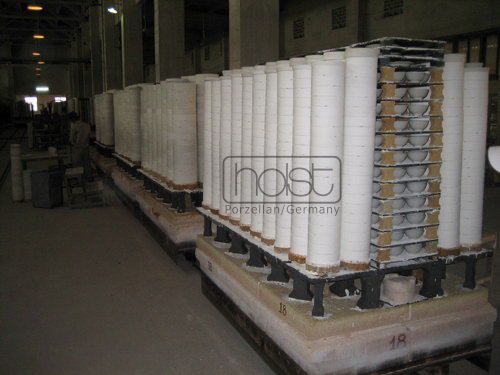Reduction firing
Reduction firing in porcelain production
In porcelain production and porcelain finishing, there are two different types of firing methods, which differ considerably and can lead to very different firing results.
- Reduction firing
- Oxidation firing
Reduction firing

The word reduction means reduction and in porcelain production means the spatial (in a circular or tunnel kiln) or temporal (in a chamber kiln) withdrawal of oxygen. Fire can only develop in connection with oxygen and similar to a gas burner, the intensity of a flame can be increased or decreased by adding or reducing oxygen (O2). The reduction in porcelain firing takes place in phases (block kiln) or zones (tunnel kiln) and must alternate with firing phases supplied with oxygen.
During the reduction firing of ceramic earths, an excess of carbon (C6) in the form of carbon monoxide (CO) is produced, which leads to a deprivation of oxygen in the kiln atmosphere and the firing material itself. A reduction firing always leads to smoke development in the kiln, which settles on the cullet as mist. Depending on the intensity and duration of a reduction firing, the cullet can change its color to a deep yellow-gray. This is a considerable disadvantage of the reduction firing and requires additional firing agents if you want to obtain white porcelain in the end.
A major advantage of the reduction firing technique is the temperature yield, which can be up to 100 °C higher than with oxidation firing.
Therefore, the capsule firing method, i.e. the use of firing capsules, is generally recommended for the reduction technique, which in turn limits the quantitative yield and effectiveness of porcelain firing.
However, the shrinkage of the porcelain mass is much more stable in the reduction firing than in the oxidation firing. Fine earth, bone china and feldspar porcelain can be fired higher in the reduction firing than in the oxidation firing. The degree of deformation is lower, the shaping structure more exact.
The reduction firing is mainly used in the subsequent finishing with decorations. Decorative colors that are produced on a metallic basis, so-called metal oxide colors, show very different reactions depending on the firing technique. As a rule, one achieves better color results with more possibilities in the reduction firing.
